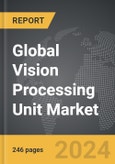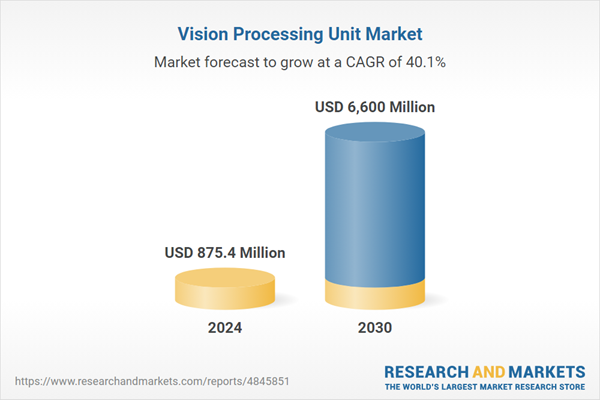The global market for Vision Processing Unit was valued at US$875.4 Million in 2024 and is projected to reach US$6.6 Billion by 2030, growing at a CAGR of 40.1% from 2024 to 2030. This comprehensive report provides an in-depth analysis of market trends, drivers, and forecasts, helping you make informed business decisions. The report includes the most recent global tariff developments and how they impact the Vision Processing Unit market.
Segments: Vertical (Aerospace & Defense, Commercial, Healthcare, Consumer, Automotive).
Geographic Regions/Countries: World; United States; Canada; Japan; China; Europe (France; Germany; Italy; United Kingdom; and Rest of Europe); Asia-Pacific; Rest of World.
The analysts continuously track trade developments worldwide, drawing insights from leading global economists and over 200 industry and policy institutions, including think tanks, trade organizations, and national economic advisory bodies. This intelligence is integrated into forecasting models to provide timely, data-driven analysis of emerging risks and opportunities.
Global “Vision Processing Unit” Market - Key Trends & Drivers Summarized
Why Are Vision Processing Units Central to Modern Computing?
Vision Processing Units (VPUs) have emerged as critical components in modern computing, particularly in applications that require high efficiency in image and video processing. VPUs are specialized processors designed to accelerate machine vision tasks, such as object detection, facial recognition, and real-time video analytics. Unlike traditional CPUs and GPUs, VPUs are optimized for visual workloads, offering significant power efficiency and performance improvements. This makes them ideal for a wide range of applications, from autonomous vehicles and drones to smart cameras and augmented reality (AR) devices. In autonomous vehicles, for instance, VPUs provide the computational power needed to process vast amounts of visual data quickly, ensuring safe navigation and decision-making. Similarly, in the smart home and surveillance sectors, VPUs enable high-performance real-time analytics for enhanced security and automation.What Technological Innovations Are Transforming Vision Processing Units?
The Vision Processing Unit market is undergoing rapid transformation, driven by advancements in artificial intelligence, machine learning, and neural network processing. Modern VPUs are increasingly integrating deep learning capabilities to enhance their performance in tasks like image classification, object detection, and semantic segmentation. This integration is making VPUs more adaptable and capable of handling more complex visual workloads with lower power consumption. The development of smaller, more energy-efficient VPUs has opened up new possibilities in mobile and embedded device markets. Furthermore, innovations in semiconductor manufacturing, such as smaller process nodes and 3D stacking, are enabling the production of more powerful and compact VPUs. These advancements are crucial for edge AI applications where real-time processing is needed without relying on cloud connectivity, making VPUs essential in IoT devices and autonomous systems.What Challenges and Opportunities Are Shaping the Vision Processing Unit Market?
Despite the growing demand for Vision Processing Units, the market faces several challenges, including high development costs and intense competition from alternative processors like GPUs and TPUs. The need for continuous innovation and rapid product cycles puts pressure on manufacturers to invest heavily in R&D. Additionally, integrating VPUs with existing systems and ensuring compatibility across different hardware and software platforms remains a complex task. However, these challenges present opportunities for further growth. The increasing demand for edge AI solutions, where devices need to process data locally with minimal latency, is driving the adoption of VPUs. The rise of smart cities, autonomous transportation, and advanced robotics further amplifies the need for high-performance, energy-efficient VPUs. Companies are also exploring new market segments, such as healthcare and retail, where VPUs can enable innovative applications like smart diagnostics and personalized shopping experiences.The Growth in the Vision Processing Unit Market Is Driven by Several Factors…
The growth in the Vision Processing Unit market is driven by several factors, including the proliferation of AI and machine learning applications, the need for high-efficiency processing in edge devices, and the rising adoption of autonomous systems. The surge in demand for real-time video analytics in surveillance, automotive, and smart city applications is a key growth driver. Additionally, the increasing complexity of AI models and the need for dedicated hardware to accelerate their processing is pushing the adoption of VPUs. The trend toward miniaturization and the need for low-power consumption in portable devices are also significant factors. Moreover, the rise of Industry 4.0 and the integration of smart technologies in manufacturing and logistics sectors are further accelerating the demand for VPUs. Collectively, these drivers are shaping a vibrant market landscape for Vision Processing Units, fostering innovation and expansion.Report Scope
The report analyzes the Vision Processing Unit market, presented in terms of units. The analysis covers the key segments and geographic regions outlined below.Segments: Vertical (Aerospace & Defense, Commercial, Healthcare, Consumer, Automotive).
Geographic Regions/Countries: World; United States; Canada; Japan; China; Europe (France; Germany; Italy; United Kingdom; and Rest of Europe); Asia-Pacific; Rest of World.
Key Insights:
- Market Growth: Understand the significant growth trajectory of the Aerospace & Defense segment, which is expected to reach US$1.8 Billion by 2030 with a CAGR of a 42.2%. The Commercial segment is also set to grow at 33.8% CAGR over the analysis period.
- Regional Analysis: Gain insights into the U.S. market, valued at $268.9 Million in 2024, and China, forecasted to grow at an impressive 38.3% CAGR to reach $941.8 Million by 2030. Discover growth trends in other key regions, including Japan, Canada, Germany, and the Asia-Pacific.
Why You Should Buy This Report:
- Detailed Market Analysis: Access a thorough analysis of the Global Vision Processing Unit Market, covering all major geographic regions and market segments.
- Competitive Insights: Get an overview of the competitive landscape, including the market presence of major players across different geographies.
- Future Trends and Drivers: Understand the key trends and drivers shaping the future of the Global Vision Processing Unit Market.
- Actionable Insights: Benefit from actionable insights that can help you identify new revenue opportunities and make strategic business decisions.
Key Questions Answered:
- How is the Global Vision Processing Unit Market expected to evolve by 2030?
- What are the main drivers and restraints affecting the market?
- Which market segments will grow the most over the forecast period?
- How will market shares for different regions and segments change by 2030?
- Who are the leading players in the market, and what are their prospects?
Report Features:
- Comprehensive Market Data: Independent analysis of annual sales and market forecasts in US$ Million from 2024 to 2030.
- In-Depth Regional Analysis: Detailed insights into key markets, including the U.S., China, Japan, Canada, Europe, Asia-Pacific, Latin America, Middle East, and Africa.
- Company Profiles: Coverage of players such as Ceva, Inc., Imagination Technologies Ltd., Inuitive Ltd., Lattice Semiconductor Corporation, Mediatek, Inc. and more.
- Complimentary Updates: Receive free report updates for one year to keep you informed of the latest market developments.
Some of the 46 companies featured in this Vision Processing Unit market report include:
- Ceva, Inc.
- Imagination Technologies Ltd.
- Inuitive Ltd.
- Lattice Semiconductor Corporation
- Mediatek, Inc.
- NextVPU
- Synopsys, Inc.
- VeriSilicon Holdings Co., Ltd
Tariff Impact Analysis: Key Insights for 2025
Global tariff negotiations across 180+ countries are reshaping supply chains, costs, and competitiveness. This report reflects the latest developments as of April 2025 and incorporates forward-looking insights into the market outlook.The analysts continuously track trade developments worldwide, drawing insights from leading global economists and over 200 industry and policy institutions, including think tanks, trade organizations, and national economic advisory bodies. This intelligence is integrated into forecasting models to provide timely, data-driven analysis of emerging risks and opportunities.
What’s Included in This Edition:
- Tariff-adjusted market forecasts by region and segment
- Analysis of cost and supply chain implications by sourcing and trade exposure
- Strategic insights into geographic shifts
Buyers receive a free July 2025 update with:
- Finalized tariff impacts and new trade agreement effects
- Updated projections reflecting global sourcing and cost shifts
- Expanded country-specific coverage across the industry
Table of Contents
I. METHODOLOGYII. EXECUTIVE SUMMARY2. FOCUS ON SELECT PLAYERSIII. MARKET ANALYSISIV. COMPETITION
1. MARKET OVERVIEW
3. MARKET TRENDS & DRIVERS
4. GLOBAL MARKET PERSPECTIVE
UNITED STATES
CANADA
JAPAN
CHINA
EUROPE
FRANCE
GERMANY
ITALY
UNITED KINGDOM
REST OF EUROPE
ASIA-PACIFIC
REST OF WORLD
Companies Mentioned (Partial List)
A selection of companies mentioned in this report includes, but is not limited to:
- Ceva, Inc.
- Imagination Technologies Ltd.
- Inuitive Ltd.
- Lattice Semiconductor Corporation
- Mediatek, Inc.
- NextVPU
- Synopsys, Inc.
- VeriSilicon Holdings Co., Ltd
Table Information
| Report Attribute | Details |
|---|---|
| No. of Pages | 246 |
| Published | April 2025 |
| Forecast Period | 2024 - 2030 |
| Estimated Market Value ( USD | $ 875.4 Million |
| Forecasted Market Value ( USD | $ 6600 Million |
| Compound Annual Growth Rate | 40.1% |
| Regions Covered | Global |









